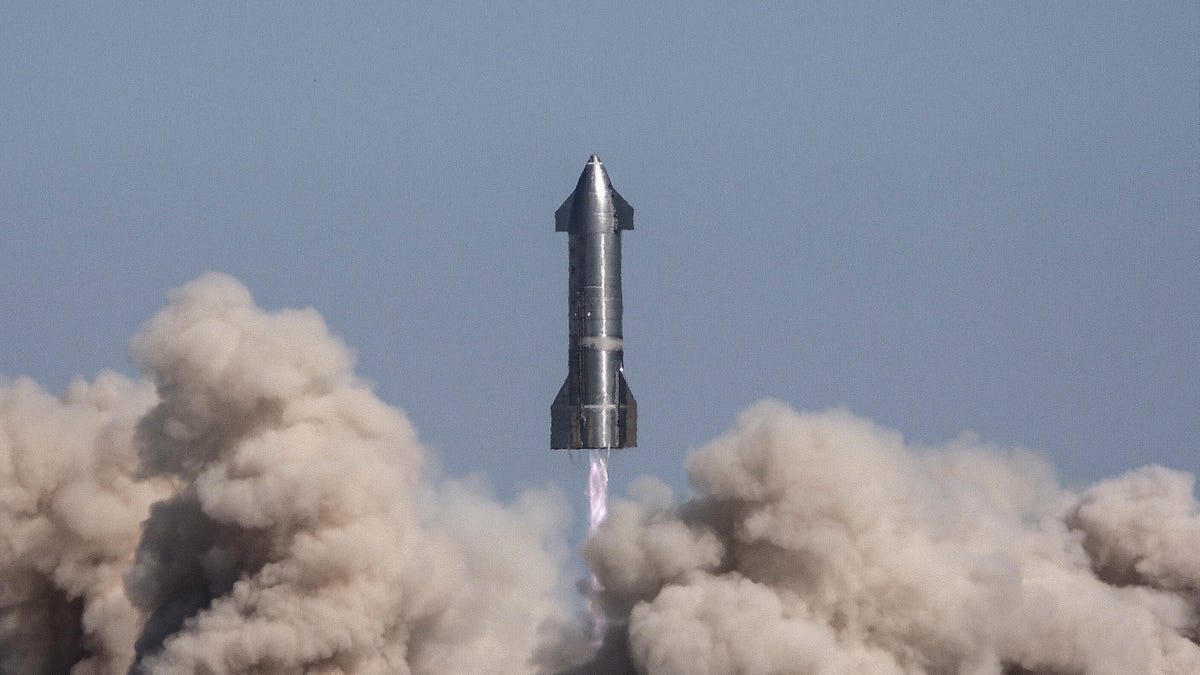SpaceX Starship SN11 test flight soars high and explodes in the fog
A launch in zero visibility comes to a dramatic but unclear end. "At least the crater is in the right place," Elon Musk says.

The SN11 Starship prototype joins its fallen suborbital siblings.
The SpaceX Starship SN11 prototype joined the company's past three prototypes in rocket heaven on Tuesday. The uncrewed flight of the next-generation rocket built by Elon Musk's space company took flight from the Starship development facility in Boca Chica, Texas, at 8 a.m. local time amid heavy fog with no real visibility.
It lit up its three Raptor engines and soared to an altitude of about six miles (10 kilometers). Onboard cameras showed SN11 flapping its flaps above the cloud bank, with a blue sky background, momentarily before beginning its descent. SpaceX cameras froze up as the Raptors began to reignite for landing, and with the fog on the ground, it's not clear exactly what happened, except that SN11 definitely exploded.
SpaceX commentator John Insprucker referred to it as "another exciting" test.
"We do appear to have lost all data from the vehicle," he said.
A later statement from SpaceX confirmed that after the landing burn started, "SN11 experienced a rapid unscheduled disassembly," adding that "teams will continue to review data from and work toward our next flight test."
Promise there's a rocket there somewhere...
It's still not clear if SN11 crash-landed, exploded in the air or perhaps the flight termination system was activated to destroy the vehicle before it hit the ground.
"At least the crater is in the right place," Musk tweeted shortly afterward. "Something significant happened shortly after landing burn start. Should know what it was once we examine the bits later today."
Looks like engine 2 had issues on ascent & didn’t reach operating chamber pressure during landing burn, but, in theory, it wasn’t needed.
— Elon Musk (@elonmusk) March 30, 2021
Something significant happened shortly after landing burn start. Should know what it was once we can examine the bits later today.
The Federal Aviation Administration will oversee a mishap investigation into the explosive landing attempt. The agency will also be looking into pieces of soft debris (possibly insulation from SN11) that fell on beaches up to five miles away.
"The FAA will approve the final mishap investigation report and any corrective actions SpaceX must take before return to flight is authorized," the agency said in an emailed statement.
The first two prototypes, SN8 and SN9, ended in dramatic explosions as they hit the pad at speed. The follow-up, SN10, made a soft landing at the Boca Chica facility on March 3, but about six minutes after it came to a stop it underwent a "rapid unscheduled disassembly" -- an explosion of epic proportions. According to Musk, the speed with which SN10 hit the pad crushed its landing legs and part of the skirt. And so, farewell.
The Starship is being designed to ferry humans around the moon and all the way to Mars, but there's a long way to go before those dreams become a reality.
The next batch of spacecraft are upgraded versions of the current prototypes, starting with SN15. The Starship is only one "half" of the vehicle that will fly further into space, too. A prototype for the first booster it will sit atop, known as the Super Heavy, is also being constructed at Boca Chica.
Follow CNET's 2021 Space Calendar to stay up to date with all the latest space news this year. You can even add it to your own Google Calendar.



